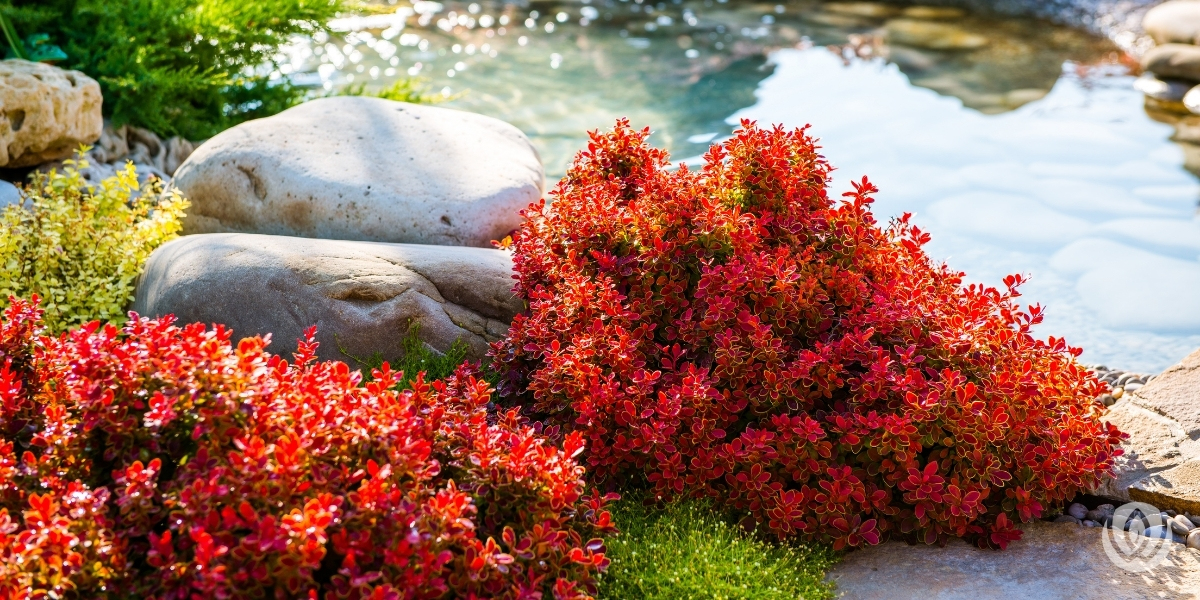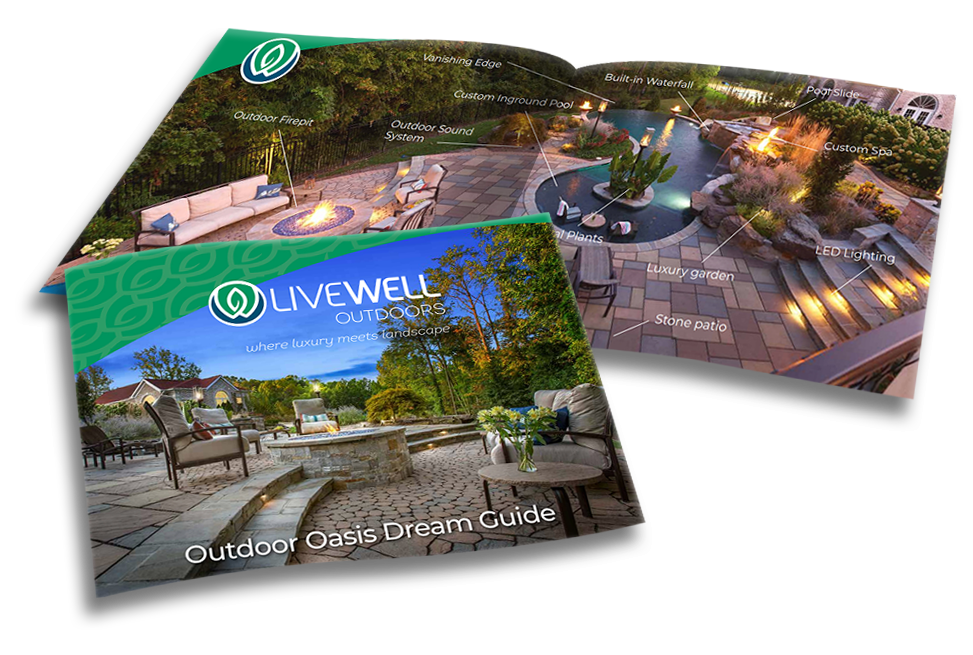
You take pride in your home’s appearance. And if you’re like most homeowners, that pride extends to your front yard, back yard, and the rest of your property. Whether you’re a do-it-yourselfer or you prefer to hire the experts to do the design and hard labor of installation, it helps to know what the various landscaping terms mean.
Like every industry, landscape design has its own language. We’ve put together this list of landscaping terms (and hardscape terms) to help you and your suppliers or contractors speak the same language. Some terms you may be more familiar with, and others may be new to you. This is by no means a comprehensive list, but covers some frequently used terms.
Let’s get started.
Aggregate – Small stone used as a sub-base for patios, walkways, and driveways. Can also be used in a decorative manner.
Annual – A plant (usually a flower) that flowers and dies in one season.
Arbor – A garden structure that frequently acts as a doorway of sorts in a garden. Used to train vines or other climbing plants.
Backfill – Gravel or dirt we use to fill in behind a retaining wall or the walls of your inground pool.
Balled and Burlapped – A tree that has been dug up, and the root ball has been wrapped in burlap.
Boulder – A large natural stone, frequently weighing over 120 pounds. Use as a decorative accent in landscape design.
Cascade – Where the water in a manmade or natural water feature reaches the edge of the vertical drop.
Concept Plan – in the landscape design process, this is the visual plan that shows you an overview of the key details.
Conifer – A conifer is a type of tree that develops cones and has needles or scale-like leaves. Examples include pine, fir, spruce, cypress, juniper, and arborvitae.
Deciduous – Shrubs or trees that drop their leaves in the fall, such as maple, oak, barberry, and azalea.
Design Elements – These are the key features of your landscape design and encompass both the living plant material and the hardscape elements. Plantings, water features, walkways, patios, are all examples.
Dry-stacked – A dry-stacked wall is one with flat rocks that are dry-stacked without the use of mortar. The wall is more decorative and is not a retaining wall.
Ecological – Also known as sustainable landscape design, ecological landscape design seeks to create a design that is compatible with your yard without making a negative impact on the environment.
Espalier – You may have seen one at a botanical garden. An espalier is a tree or shrub trained to grow flat against a wall.
Evergreen – A shrub or tree whose leaves or needles stay green all year long. Examples include pine trees and boxwood.
Flagstone – Large flat stones (or pavers) we use to create walkways and patios.
Focal Point – An element in any area of your landscape design that you want to be most prominent. In an outdoor living space, this could be the outdoor fireplace. In a garden, it could be a favorite tree, or a fountain, for example.
Foundation Plantings – As the name implies, these are plantings located in garden beds near your home’s foundation.

Gazebo – A roofed structure with fully open or partially open sides, typically with a floor or on a concrete slab. Frequently octagonal or round in shape.
Grading – Grading changes the level of your soil to improve drainage, provide more usable space, or prepare for a patio installation.
Groundcover – A type of plant that grows low to the ground and spreads easily. Often used to help prevent erosion.
Harden Off – Allowing a plant that has been grown indoors or in a sheltered area time to acclimate gradually outdoors before planting it. This may happen at a greenhouse before the plant ever makes its way to you.
Hardscape – Any design element in your landscape design that is not plant material. This includes natural and man-made elements such as boulders, rock, pathways, patios, retaining walls, etc.
Herbaceous – Annuals and some perennials without woody stems, that die down to the ground in the winter.
Informal – As opposed to the formal gardens of England with straight lines, informal gardens and landscapes is dominated by curved lines and sometimes naturalized areas.
Invasive – A plant that spreads quickly into areas where it is not wanted, frequently doing damage. Examples include English ivy, Japanese barberry, and Japanese honeysuckle.
Irrigation – Watering your lawn and plants with a sprinkler or irrigation system.
Japanese Beetle – An iridescent green-headed beetle with a copper body and voracious appetite that can leave some of your plants skeletonized.
Japanese Garden – A special style of garden with a minimalist, natural setting designed to encourage self-reflection and meditation. Frequently includes a small bridge and water feature.
Kitchen Garden – A small garden generally grown in raised beds and located as close to your kitchen as possible. May be placed on your patio or right next to it. Perfect for herbs, lettuce, tomatoes, etc.
Koi – A type of fish placed in ornamental ponds or water gardens.
Kudzu – An invasive vine originally introduced in the U.S. to prevent erosion, Kudzu is more common on the edge of forested areas and roadsides. May also be present on farmland that has recently switched to residential development.
Landscape Design – The art and science of designing landscapes for both aesthetic and practical reasons.
RELATED READING: Landscape Design: How to Get It Right
Landscape Designer – The professional who plans and develops your landscape design. The designer might be with the same company that installs your plantings and hardscape elements.
Lime – Lime is a calcium material we can use to raise the pH in your lawn, to make it harder for moss to grow.
Mass Planting – An excellent option when you have a large space, including a hillside, a mass planting is where we plant many of the same flower or bulb close together for dramatic effect.
Moss Garden – This is an area where you actually encourage moss to grow as a ground cover, or on rocks in a shaded or moist area. Pairs well with ferns and water gardens.
Mulch – Any material used as a cover of bare soil to prevent weed growth and retain moisture. Includes shredded wood bark, pine straw, landscape rock, etc.
Native Plant – Any grass, flower, groundcover, shrub, or tree that was present in an area naturally, before humans started introducing new plant matter.
RELATED READING: Why You Should Use Native Plants in Your Landscape
Naturalize – Plants you add to the garden or yard that you want to appear as if they grew there as nature intended. This is an informal look. Bulbs and perennials are good options for this, as they spread easily.
Nursery – A plant nursery is a direct source of a variety of plant material. They plant some species from seed, and propagate others and then sell them to landscaping companies and the general public.
Organic – Related to plant material rather than chemicals, such as organic fertilizer.
Ornamental Grass – Any taller grass (not turfgrass) used in landscape design for its height, texture, and color.
Outdoor Living Area – This is typically the space behind your home, or the backyard. It encompasses your deck, patio, outdoor kitchen, pool area, or other space where you play, eat, and entertain.
Perennial – A type of flower or grass that comes back year after year, and will spread. Examples include purple coneflower, Black-Eyed Susan, and many bulbs.
Pergola – An open-sided, open-roofed structure on your patio or in a garden area.
Pavilion – A pergola with a fixed roof. Frequently used to shelter an outdoor kitchen/outdoor dining room.

Rain Garden – A garden specifically designed to help handle large amounts of rainwater until it can percolate into the ground. Will have special wet-tolerant plantings.
Retaining Wall – A wall built with stone or interlocking pavers, and specially designed to stop erosion and stabilize slopes. Can also be decorative around a patio and used for extra seating.
Rock Garden – A specialty garden, consisting mostly of various-sized rocks, groundcover, succulents, and other plants that can thrive in rocky soil.
Screening Plantings – Trees, shrubs, and hedges we use to block a view, provide privacy, or act as a dividing line.
Setback – The space near your property lines where local regulations or HOA regulations restrict what you can install or build.
RELATED READING: Navigating HOA Rules When It Comes to Your Outdoor Living Space
Specimen Plant – A striking tree or shrub in prime condition, used as a focal point in landscape design.
Terrace Garden – A garden built on a slope, by the use of grading and retaining walls to create flat spaces for gardens.
Topiary – A decorative plant that is pruned and sheared into a decorative shape.
Turf Grass – The grass in your lawn. Tall fescue is an example.
Variegated – An adjective used to describe a plant’s leaves that have one or more distinct colors, one of which is usually white or cream-colored. Examples include some hostas and coleus.
Verticillium Wilt – A common, soil-borne fungus that can cause many kinds of plants, trees, and shrubs to wilt and rot.
Volunteer Seedling – A seedling that comes up on its own without being planted. This can be self-seeding from a perennial or tree dropping seed pods or acorns, or from bird droppings or a squirrel burying a nut and not finding it during the winter. These can be left where they are, pulled, or transplanted.
RELATED READING:
We hope this listing of some lesser-known landscaping terms helps you communicate your ideas clearly.
If you’re looking to upgrade your landscape design, or you’re starting from scratch at a newly built home, we can help. Our team is expert in overall landscape design, including landscaping and hardscaping design and installation. From plant material to a new patio to an inground pool, we do it all.
You have ideas. We have the skill and expertise to turn them into reality. We work with homeowners throughout the Capital Region, in Maryland, DC, and Northern Virginia. Schedule a consultation by filling out the contact form, or call us at 301.720.1000.
